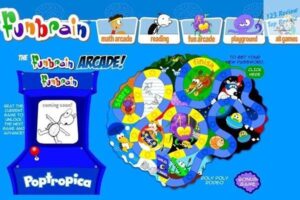Sesame Street games feature beloved characters like Elmo, Big Bird, and Cookie Monster, offering fun ways to learn numbers, letters, shapes, and problem-solving skills. Whether played online, on mobile devices, or through physical board games, Sesame Street games provide a playful approach to early childhood education, making learning engaging and accessible for kids.
In this article, 123 Review explores how these games combine fun and education to engage young learners, helping them develop critical skills such as literacy, numeracy, and problem-solving.
The Critical Role of Sesame Street Games in Early Childhood Education
The Educational Value of Interactive Learning
Sesame Street Games have become a cornerstone in early childhood education, blending the engaging world of play with critical educational content. Interactive learning is at the heart of these games, offering a dynamic and immersive experience that encourages active participation from young children. Unlike passive learning methods, where children are mere recipients of information, interactive learning transforms them into active learners. This approach taps into a child’s natural curiosity, prompting them to explore, experiment, and engage with the content in a meaningful way.

For example, a game that involves helping Elmo identify shapes or colors requires children to think critically and make decisions, reinforcing their understanding through repetition and interaction. These games are not just about entertainment; they are carefully crafted to build foundational skills in literacy, numeracy, and problem-solving. By embedding educational content within a playful framework, Sesame Street Games make learning a natural and enjoyable process, one that children are eager to participate in.
Engagement Through Familiar Characters
One of the most powerful elements of Sesame Street Games is the use of familiar and beloved characters like Elmo, Big Bird, Cookie Monster, and Abby Cadabby. These characters are more than just animated figures on a screen; they are trusted friends who have been a part of children’s lives for generations. Their presence in the games helps to create an emotional connection that enhances the learning experience. Children are more likely to engage with content that features characters they know and love, making the educational messages within the games more impactful.
This engagement is crucial during early childhood, a period when children are developing not only cognitive skills but also social and emotional competencies. By interacting with these characters, children learn important social skills such as empathy, cooperation, and emotional regulation. For instance, a game where Big Bird teaches children about sharing helps to reinforce these values in a way that is relatable and understandable for young learners.
Exploring the Different Types of Sesame Street Games
Online Interactive Games: A World of Learning at Your Fingertips
The digital revolution has brought with it a wealth of opportunities for interactive learning, and Sesame Street has fully embraced this with a variety of online games. These games are designed to be accessible on multiple platforms, including desktops, tablets, and smartphones, making them available to children wherever they are. The online games cover a wide range of topics, from basic concepts like counting and the alphabet to more complex subjects like science and social-emotional learning.
One of the standout features of these online games is their adaptability. Many of them are designed with algorithms that adjust the difficulty level based on the child’s performance. This means that if a child is struggling with a particular concept, the game will provide additional support and practice opportunities. Conversely, if the child is excelling, the game will introduce more challenging tasks to keep them engaged. This personalized learning experience is one of the key reasons why Sesame Street Games are so effective in supporting early childhood education.
In addition to adaptability, these games are designed to be visually and audibly stimulating, using bright colors, engaging animations, and cheerful music to captivate young learners. The use of clear, concise voiceovers ensures that instructions are easy to follow, allowing children to navigate the games independently. This not only builds their confidence but also encourages a sense of autonomy and responsibility in their learning journey.
Printable Activity Sheets: Bridging Digital and Physical Learning
While digital games offer many benefits, there is also value in offline activities that can complement the online learning experience. Sesame Street provides a wide array of printable activity sheets that can be used to reinforce the concepts learned in the digital games. These activity sheets include coloring pages, puzzles, cut-and-paste crafts, and mazes that focus on developing fine motor skills, creativity, and problem-solving abilities.
For instance, a coloring page featuring Elmo holding different objects can help children practice color recognition and hand-eye coordination. A maze where Big Bird needs to find his way home encourages children to think critically and plan their moves. These activities are not only educational but also provide a tactile learning experience that is crucial for young children. By combining digital and physical learning resources, Sesame Street Games offer a comprehensive educational approach that caters to different learning styles and preferences.
These printable sheets are also a great resource for parents and educators who want to engage children in learning activities without relying solely on screen time. They can be used at home, in the classroom, or on the go, providing a versatile tool for reinforcing learning concepts in various settings.
Key Features of Sesame Street Games
User-Friendly Interface: Designed with Young Learners in Mind
When designing educational games for young children, usability is a critical factor. Sesame Street Games excel in this regard, offering an interface that is both intuitive and accessible to even the youngest users. The games feature large, colorful buttons, simple and clear instructions, and a layout that is easy to navigate. This user-friendly design ensures that children can engage with the content without feeling overwhelmed or frustrated, allowing them to focus on the learning experience.
In addition to the visual design, the games also incorporate auditory cues that guide children through each step. Friendly voiceovers from familiar Sesame Street characters provide encouragement and direction, helping children understand what is expected of them. This multimodal approach—combining visual, auditory, and kinesthetic elements—enhances the learning experience by catering to different sensory preferences. The result is an educational tool that is not only effective but also enjoyable for young learners.
Diverse Learning Topics: A Comprehensive Educational Resource
Sesame Street Games are known for their wide range of educational content, making them a valuable resource for holistic early childhood development. The games cover a broad spectrum of topics, including literacy, math, science, social studies, and social-emotional learning. This diversity ensures that children are exposed to a variety of concepts and skills, helping them develop into well-rounded individuals.
For example, math games might involve helping Count von Count tally up objects, reinforcing basic counting skills and number recognition. Literacy games often focus on letter identification, word matching, and phonemic awareness, laying the groundwork for reading fluency. Science games might introduce children to concepts like weather, seasons, and the life cycles of plants and animals, fostering a sense of curiosity about the natural world.
Social-emotional learning is another key focus of Sesame Street Games. Through interactive scenarios, children learn about emotions, empathy, friendship, and cooperation. A game where Abby Cadabby helps her friends solve a problem might teach children about teamwork and problem-solving, while a game focused on Big Bird’s feelings could help children understand and manage their own emotions. This well-rounded approach ensures that Sesame Street Games support not only cognitive development but also social and emotional growth.
Parental Feedback on Sesame Street Games
Positive User Experiences: A Parent’s Perspective
The feedback from parents regarding Sesame Street Games is overwhelmingly positive, reflecting the games’ ability to balance education with entertainment. Parents often praise the games for their educational value, noting that they are not just a distraction but a meaningful way for their children to learn and grow. Many parents report that their children show significant improvement in skills such as counting, letter recognition, and problem-solving after regularly engaging with these games.
Parents also appreciate the safe, ad-free environment that Sesame Street Games provide. In an era where many online games are filled with advertisements and potentially inappropriate content, Sesame Street Games stand out as a trustworthy option. This peace of mind is invaluable for parents who want to ensure that their children are exposed to quality content that is both safe and educational.
Concerns Regarding Screen Time: Striking the Right Balance
Despite the many benefits of Sesame Street Games, some parents have expressed concerns about the amount of screen time their children are accumulating. While the games are designed to be educational, the interactive and engaging nature of these games can make it difficult for children to stop playing, leading to prolonged periods of screen use.
To address these concerns, it is important for parents to establish clear guidelines around screen time. Experts recommend that screen time for young children should be balanced with other activities that promote physical movement, social interaction, and creative play. By setting time limits and encouraging breaks, parents can help ensure that their children enjoy the educational benefits of Sesame Street Games without the drawbacks associated with excessive screen time.
Parents can also incorporate the printable activity sheets offered by Sesame Street into their child’s daily routine, providing an offline complement to the digital games. These activities help to diversify the learning experience and reduce reliance on screens, ensuring a well-rounded approach to early childhood education.
The Impact of Sesame Street Games on Language Development
Phonics and Vocabulary Acquisition: Building Blocks of Language
Language development is a key area where Sesame Street Games excel, particularly in teaching phonics and vocabulary. Many of the games are specifically designed to help children recognize and pronounce letters and sounds, which are the building blocks of reading and writing. For example, a game where children help Elmo find items that start with the letter “B” reinforces the connection between the letter and its sound, aiding in phonemic awareness.
In addition to phonics, Sesame Street Games are highly effective in introducing new vocabulary words. The games often present words in context, which helps children understand their meanings and how they are used in everyday language. For instance, a game where Cookie Monster talks about different types of food introduces children to a variety of food-related vocabulary, enhancing their language skills in a fun and engaging way.
By regularly playing these games, children are exposed to a rich linguistic environment that supports both their expressive and receptive language skills. This exposure is crucial during the early years, as it lays the foundation for later success in reading, writing, and communication.
Enhanced Comprehension Skills: Understanding Through Interaction
Beyond phonics and vocabulary, Sesame Street Games also play a significant role in developing children’s comprehension skills. Comprehension involves understanding the meaning of what is read or heard, and it is a critical component of literacy. Through interactive storytelling and problem-solving scenarios, Sesame Street Games challenge children to think critically about the content they are engaging with.
For example, a game where children need to follow a sequence of events to help a character solve a problem encourages them to pay attention to details, make connections, and predict outcomes. These are all essential comprehension skills that will serve them well as they progress in their education.
The use of familiar narratives and characters also helps to reinforce comprehension. When children see Elmo or Big Bird in a situation they can relate to, they are more likely to understand and retain the information being presented. This familiarity makes it easier for children to grasp new concepts and apply them in different contexts, enhancing their overall understanding of the world around them.
Comparing Sesame Street Games to Other Educational Games
Unique Selling Points of Sesame Street Games
In a market saturated with educational games, Sesame Street Games stand out for several reasons. First and foremost is the brand’s long-standing reputation for quality and trustworthiness. Parents and educators alike have relied on Sesame Street for decades as a source of reliable and effective educational content. This trust extends to the games, which are developed with the same commitment to excellence that has characterized the Sesame Street brand from its inception.
Another unique selling point is the integration of beloved Sesame Street characters into the games. These characters not only make the games more engaging but also provide a sense of continuity for children who watch the Sesame Street television show. This multi-platform approach ensures that the lessons learned in the games are reinforced across different media, creating a cohesive learning experience.
The educational content of Sesame Street Games is also a key differentiator. The games are designed by experts in early childhood education, ensuring that they are developmentally appropriate and aligned with educational standards. The use of research-based methods to teach critical skills such as literacy, math, and social-emotional learning sets Sesame Street Games apart from many other educational games that may prioritize entertainment over education.
Limitations Compared to Other Brands
While Sesame Street Games have many strengths, they are not without their limitations. One of the main criticisms is that the games, while highly effective for young children, may not offer the same level of challenge for older children or those who are more advanced in their learning. As a result, parents may need to supplement Sesame Street Games with other educational resources as their children grow and their needs evolve.
Another limitation is the relatively narrow focus of some of the games. While they cover a wide range of topics, the depth of content in each area may not be as extensive as that offered by specialized educational games. For instance, a game that focuses on basic counting skills may not delve into more complex mathematical concepts like addition or subtraction, which are covered more comprehensively in other educational games.
Finally, while the user-friendly interface of Sesame Street Games is a major advantage for younger children, it may be seen as too simplistic for older children who are accustomed to more sophisticated gaming experiences. This simplicity, while beneficial for ease of use, may limit the games’ appeal to a broader age range.
Conclusion: The Lasting Impact of Sesame Street Games on Early Childhood Development
Sesame Street Games have proven to be an invaluable tool in the realm of early childhood education. By combining interactive learning with beloved characters and a user-friendly design, these games offer a unique and effective way for children to develop essential skills in literacy, math, and social-emotional learning.
The diverse range of games and printable activities ensures that children are exposed to a variety of educational content, catering to different learning styles and preferences. Parental feedback has been overwhelmingly positive, highlighting the games’ ability to engage children in meaningful learning experiences while providing a safe and trustworthy environment.
While there are some limitations to consider, such as the potential for excessive screen time and the need for additional resources as children grow older, the overall impact of Sesame Street Games is undeniably positive. As parents and educators continue to seek out high-quality educational resources in an increasingly digital world, Sesame Street Games remain a trusted and effective option for supporting early childhood development.





